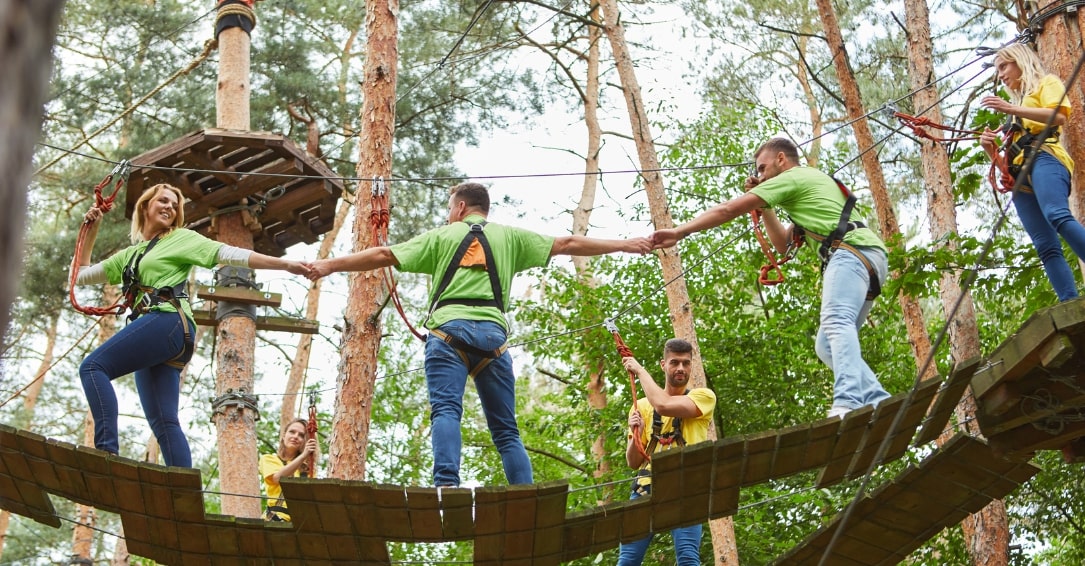How to Plan a Memorable and Productive Staff Retreat

Every organization has a common goal – get work done through people to accomplish the company’s overall mission. There are several tools, meetings, and benchmarks that help us to stay organized and connected to reach our goals, but the true magic happens when an executive team decides to get their entire team together at an offsite location to help shake things up, get creative juices flowing and increase employee morale.
Staff retreats have been proven to be a great way to enhance company culture, improve overall team performance, and increase employee productivity and engagement. It also gives space for employees to undergo leadership development and increase their confidence.
So how do you take a group of people with different tastes and preferences and plan a retreat that everyone will enjoy? We’re sharing a few tips on how to plan a memorable and productive staff retreat.
Decide what you want to get out of the staff retreat.
To get the most out of your team retreat, understand what you want attendees to walk away with after hosting it. Do you want to reignite employee passion, nip office politics in the bud, improve overall team dynamics, or develop new and innovative business strategies? Make a decision and create activities that will push those goals forward.
Set a budget.
Consider factors that could affect the event’s budget and execution – transportation, accommodations, meals, guest speakers, and team activity supplies and facilitators. Map out where you can cut costs and where you should spend the most money and effort.

Pick an accessible and unique location.
Picking a location is one of the most important decisions you’ll make during your team retreat planning process because it directly impacts the team retreat costs and overall satisfaction. Do your research to get recommendations from other business leaders who have hosted successful team retreats, and consider getting an event planner if you have the room in your budget. A planner will ensure the retreat location is a new and exciting place for your team while also ensuring the site is accessible travel-wise while simultaneously staying within your budget.
Be mindful of the retreat’s time frame.
There are several reasons to be mindful of the time frame of your retreat. Logistically, you must consider the time of year, especially if you are planning outdoor team-building activities. Avoid hectic seasons of the year and of your company, and more than anything, we recommend that the retreat is scheduled before the executive team makes end-of-year plans and decisions so you can get ideas and input from the people who will actually be executing the projects. Finally, when you consider the actual length of the event, if you can stretch the event to be a multi-day event, you will have the opportunity to spend more time in “retreat mode” and give employees more time to open up, share ideas, and have fun.
Plan engaging activities.
The best team retreats host a combination of fun, reflection time, working sessions, and team-building activities. There must be a happy balance between completing work tasks and cutting loose. Your retreat plans should include activities that connect people who, under normal office circumstances, may not interact. For instance, host an ice breaker where all staff members have to engage and meet staff members from other departments.
Leaders and managers should also remember to relax, be approachable and participate in all activities. A staff retreat is one of the times (in some cases, the only time) that employees get to see you outside of the office and get to know you personally. Being more accessible and touchable will make employees feel connected, increasing their morale and engagement.

Form a planning committee and involve the staff early on in the process.
You can get your staff involved before the retreat by forming a planning committee to help you formulate ideas and activities for the event. Not only will you gain partners to help you execute the event, but you will also get staff members excited about the event, which is never bad. Consider pulling a staff member from each department to join the committee so you can gain input across all departments. Conduct a pre-event survey to ask staff members about food allergies, preferred dates, and other vital details that can help you to plan well.



